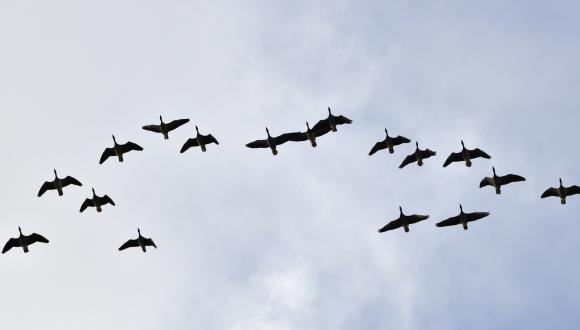South Walls Local Goose Management Scheme
This aims to maintain sustainable populations of wintering Greenland barnacle geese on South Walls and minimise agricultural damage and economic losses.
Scheme overview
Location: South Walls, Orkney
Goose species: Greenland barnacle goose
Extent: 80 hectares approx. of agricultural land
Population level: 1,516 geese (average count in 2013/14)
Number of participants: 3 holdings
Duration: 4 years, from October 2017 to April 2021 (a series of one-year management agreements run from 1 October to 30 April annually)
Eligibility
To be eligible, agricultural land must:
- lie within an area of high goose use
- be permanent or rotational grassland and in a suitable condition to attract geese
View a map of eligible fields below.
Read the South Walls Local Goose Management Scheme eligibility table
How to apply
You must identify on a map the locations of any areas to be managed under this option each year.
You must keep records of:
- reseed frequency for pasture on your holding
- silage cutting dates
- silage yield
- stock turnout dates
You should submit this information with your application to join the scheme.
Download the South Walls Local Goose Management Scheme application form
Management requirements from 1 October to 30 April (inclusive)
Provision of undisturbed feeding refuge
- Provide undisturbed ground for goose feeding.
- Apply extra fertiliser in the spring and autumn to make the sward attractive to geese.
- Goose scaring may only take place in the buffer area (first-year reseeds next to the feeding zone) – and then only using non-lethal ‘quiet’ methods (i.e. no gas guns, rope bangers or shooting).
- Land managers who choose to undertake non-lethal scaring are responsible for buying and erecting any scaring equipment.
- You must get a licence to shoot barnacle geese if you wish to use lethal scaring methods outside the feeding zone and buffer area.
Payment
View South Walls Local Goose Management Scheme Payment rates.
Monitoring
Goose numbers and distribution
We monitor goose numbers and goose distribution on South Walls weekly from late October to late March, following a standard route.
Proportion of the goose population supported by the scheme
We use annual goose counts to estimate the proportion of the goose population supported under the scheme.
Agricultural damage monitoring
Our Goose Officer monitors damage three times during the goose season. A Scottish Government Rural Payments and Inspections Directorate (SGRPID) Agricultural Officer also visits once, in June, to inspect for damage.
Farmer perception monitoring
NatureScot issues a questionnaire at the start of the scheme and towards its end. This asks land managers about their perceptions of the scheme, their level of satisfaction with it, and levels of damage caused by geese.
Cropping practices
The following cropping practices will be monitored for a sample of participants each year: reseed frequency, silage cutting dates and stock turnout dates.
Inspections
The following ensure compliance with the scheme’s eligibility criteria and management requirements.
Before land joins the scheme, NatureScot will check its goose count data for the previous year and Integrated Administration and Control System (IACS) data for the current year. The land will be visited before 31 December to ensure it meets the eligibility criteria.
Field size and boundary data will be checked against current IACS data before payments are made. Field size is checked, and payments are made, against the net field area stated on the current season’s Single Application Form.
While the scheme is operating, only quiet scaring methods may be used in buffer areas. Inspectors will note where and when scaring devices are in use.
If you carry out lethal scaring of barnacle geese, we will check that you hold a licence to do so on your land.




